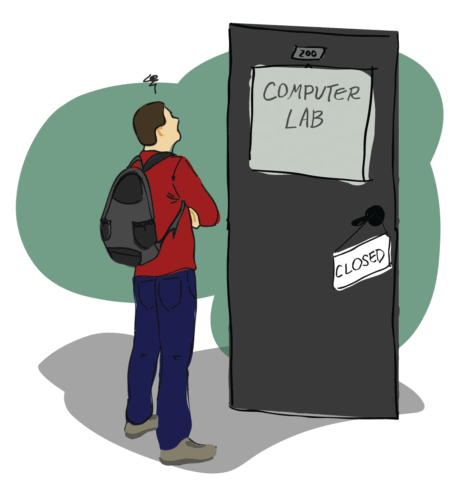It’s the Internet’s world out there and while usually I’m the first to defend the usefulness of everything digital, there are a few reasons to be down on the University of Saskatchewan’s dependance of technology — especially if you don’t have your own computer.
Dependence might be a strong word, but it is pretty succinct. It pays to have access to a laptop or even a tablet on campus, as it keeps us students completely mobile and connected to everything that the U of S has to offer.
The vast majority of university resources are online. In order to keep up with your courses, having access to the web is a must, and everyone should make sure they have email coming to their smartphones for those last minute class cancellations.
Departments, services and centres on campus list their information on usask.ca, and Blackboard contains everything from course materials to quizzes and assignment  submissions.
submissions.
A lot of classes now post notes and the majority of their content online, and while that can be extremely helpful on those mornings you sleep in or miss the bus, it means less to those who have no way to access that content outside of campus.
Being able to take notes in that lecture with that professor who talks inhumanly fast is so much easier when you can type rather than write. Having unit quizzes on Blackboard seems like a great idea until you have to try and finish them in Murray Library before you head home for the night. The main form of communication on campus has become email, which is only useful if you can check your inbox fairly regularly.
It has become extremely difficult to be a student without access to a computer at the U of S, and while to some it seems strange to not have a computer, for others it’s a reality. Computers are expensive, and not everyone can afford to drop a wad of cash on a new laptop.
The university does have a number of public computers on campus — but they come with strings.
Most computer labs are located within a college, and thus are only available for students from that college. If a computer lab is booked, which is not uncommon, that lab is only open to the class who booked it, and all booking requests are done through a form submitted — you guessed it — online.
Places like the lounge in McLean’s Hall or room 373 in the Kinesiology Building are public access computers that are open to any student, but only during building hours. There are computers available in the Learning Commons in almost all of the larger libraries, open during library hours.
There aren’t many computers located in the stacks at Murray, so you have to carry your research materials down to the first floor to work — if you’re at all like me and need your references laid out in front of your face.
The computers located in the Arts Tunnel are the only on-campus computers available 24 hours a day for anyone, but they also aren’t really made for working on homework, with the unusual height of the counters, lack of chairs and high traffic location.
Trying to juggle your time on campus around when you can sit down at a computer is another stress added to the pressure of a university course load, and it unfairly disrupts the playing field. Those who have access to a laptop or computer outside of campus have an immediate advantage: instant access to essentially everything.
Long nights in the library and last minute additions to research papers aren’t as nonchalant when they require you to first find a usable computer on campus. And while the lure of a paperless university existance is tempting, there are things that could be left off the Internet, like mandatory quizzes and assignments that can only be submitted via Blackboard.
While laptop users can complain about the sketchiness of the university’s public WiFi all they want, it doesn’t quite compare to the uncertainty of only using public computers on campus.
—
Larissa Kurz / Copy Editor
Graphic: Lesia Karalash / Graphics Editor